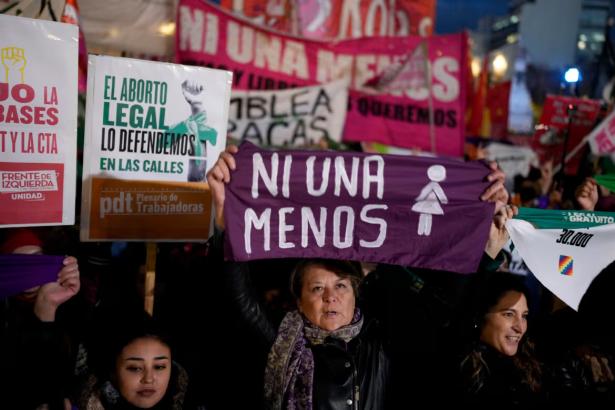Ni Una Menos Is ‘Building a New Generation of Militancy’ Against Physical and Economic Violence
The rise of Ni Una Menos marks a before and after in the history of Argentine. The movement against sexist violence, established in 2015, changed the history of Argentine feminism and showed the rise of the transfeminist masses as a political subject.
In nearly 10 years of struggle, the movement shone a spotlight on all forms of violence against women and dissident subjectivities through protesters’ bodies occupying the streets, marching and organizing assemblies in working-class neighborhoods and universities. It has named femicides in plain language and made them impossible to sweep under the rug.
“Ni una menos!” (“Not one woman less!”) was the rallying cry for the thousands of people who took part in the first historic march, which took place on June 3, 2015 in Buenos Aires and 120 other cities across the country in reaction to the brutal femicide of Chiara Páez, killed at age 14 by her boyfriend because she was pregnant.
It was neither the first nor the last such killing, but Chiara's death was the fuse that lit the fire. The movement would return to the streets the following year, on June 3, 2016, after the femicide of Lucía Pérez, who was raped and murdered at age 16. “We want us to be alive, we want us to be free,” was the slogan in the streets for a mobilization that was the starting point of a mass protest movement.
Since then, Ni Una Menos has given rise to “many changes in society, mainly in sensibilities and social relations at the personal, labor, student, union, and institutional levels,” researcher and sociologist Lucy Cavallero, an activist in the movement, tells il manifesto. “It started off a social process in which levels of tolerance toward gender-based violence are changing. It has challenged patriarchal hierarchies and started a political mobilization about everyday life that was not visible or conscious before,” she adds.
The changes can be seen in the ways of taking over the streets: in the posture and gaze with which feminisms are developing and organizing action in union spaces, schools and universities. It is a desire for collective decision-making, a form of political imagination. In the gatherings, participants share their urgent concerns, feelings and strengths.
“A new generation has begun its militancy in this cycle of protests” where an intersectional critique is being built, researcher and activist Veronica Gago tells il manifesto. “Ni Una Menos has built up the possibility of connecting very different battles from the grassroots level. It has embodied the words of Angela Davis: struggles for justice are indivisible. Fighting femicides leads to thinking about how they tie in with police violence and housing violence. It’s not just a theoretical approach: it is a work of political coordination.”
Since 2017, Ni Una Menos began a reflection on economic violence and the consequences of foreign debt on daily life. The strike as a means of protest has made it possible to talk about unpaid work, making visible in the public space what had been confined to the space of the home: the inequality in the labor force and the unpaid hours of care work.
With the feminist strikes, linked to the tradition of political and social struggles in Argentina, the movement expanded to women working in the underground economy and organizations for a people’s economy, questioning the very idea of what labor is.
In its work setting up alliances across the local territories, Ni Una Menos was instrumental in strengthening gender policies in Argentina and in securing legal, safe and free abortion. In the span of time between 2015 to 2023, the Ministry of Women, Gender and Diversity was set up; laws were enacted to guarantee economic support to those subjected to violence and to the families of victims of femicide; and training on gender and violence was made mandatory for those working in public sectors, making it compulsory to use inclusive language.
Far-right President Javier Milei with his proverbial chainsaw has mounted a full-scale attack against all of these gains.
“These are revolutionary changes, hence the level of fascist neo-conservative reaction we are experiencing. We are facing a global phenomenon that has its own peculiarities in Argentina, which saw a feminist movement in the streets, an intergenerational mass movement. They find it unbearable that the right to abortion has been won, involving the public health institutions, and that sex education is being taught in schools. They’re talking about a birth rate crisis because over ten years the numbers of teenage pregnancies has decreased by 50 percent,” Veronica Gago adds.
“They cannot tolerate the fact that feminism is denouncing the debt of the country and of families, the fiscal injustice that supports oligarchies and extractive projects. And, most of all, the fact that it is not a neoliberal ‘empowerment’ movement.” Instead, it is a collective desire to change everything.
Originally published at https://ilmanifesto.it/ni-una-menos-la-miccia-che-accese-il-fuoco-e-il-desiderio-collettivo-di-cambiare-tutto on 2024-11-23
Il manifesto was founded in 1969 on the idea that truth and freethinking are more important than everything else, including profit. The paper pays for its editorial idealism in the form of lost advertising. But we more than make up for this in the support of tens of thousands of subscribers who believe a better world is possible. There are no owners (il manifesto is a cooperative), and the editor and managers are elected every four years by the employees. We maintain a newsroom in Rome and correspondents around the world, filing dispatches from Paris, London, Berlin, Jerusalem, Havana, New York, Los Angeles and elsewhere.


Spread the word